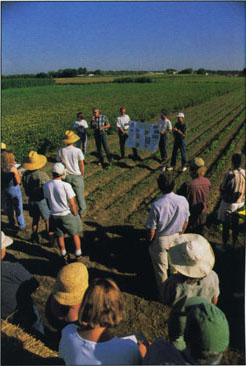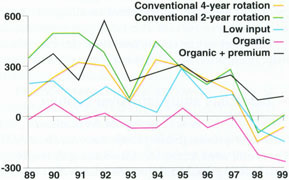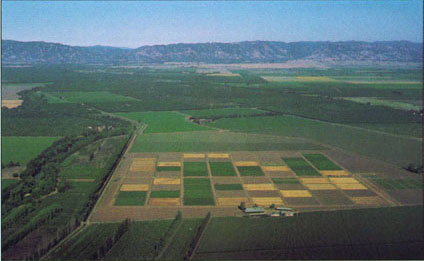All Issues
Organics profit from premiums
Publication Information
California Agriculture 54(4):13-14.
Published July 01, 2000
PDF | Citation | Permissions
Full text
Organic crop production costs more than traditional farming, but it can be economically viable as long as the organic crops are sold at premium prices, according to a study of alternative farming practices.
This is the last season of the 12-year Sustainable Agriculture Farming Systems (SAFS) Project. The UC Davis study is comparing conventional cultural practices with low-input and organic farming systems for crop rotations typical to the Sacramento Valley.
The 28-acre research project includes a 2-year conventional system alternating tomatoes and wheat and a 4-year, five-crop rotation for conventional, low-input and organic systems. The 4-year rotations include processing tomatoes, safflower, corn and a winter grain (wheat for the conventional systems and an oat/vetch mix for the low-input and organic systems) followed by a double crop of beans. The low-input and organic systems incorporate alternatives to conventional pest-control practices and the use of nitrogen-fixing cover crops preceding the planting of tomatoes, safflower and corn. Furrow irrigation is used for crop production in all four systems.
Some consumers are willing to pay more for produce grown without pesticides than for conventionally grown produce. As demand for organic food rises, more organically grown produce has been garnering price premiums.
From 1989 through 1999, organic plots that received premiums showed an average net return of $258 per acre per year, whereas conventional 2-year plots showed a net return of $262 per acre, says UC Davis agricultural economist Karen Klonsky, who evaluated the whole farm performance of each farming practice. Without price premiums, the organic system lost an average of $56 per acre.
With price premiums, the organic system showed the highest net income of all the 4-year systems in 8 out of 10 years and exceeded the 2-year conventional system in 4 years. On average, the low-input system outperformed the organic system with conventional prices, but fell below the two conventional systems.
To compare the magnitudes of the price premiums received for the organic SAFS crops, the premiums can be expressed as the percentage over conventional prices. Using this measure from 1989 to 1999, organic processing tomatoes have averaged a 54% price premium, organic beans 41%, organic corn 29% and organic safflower 28%.
“Looking at the most recent five years,” Klonsky says, “the relative price premiums have changed, with tomatoes falling to only 38%, and beans, corn and safflower rising to 64%, 44% and 40%, respectively. Processing tomatoes are the only crop for which the price premium actually decreased steadily from 1989 to 1996, but increased in 1997 and again in 1998.”
Organic price premiums for beans were not available until 1992, increasing steadily to 94% in 1996, dropping dramatically to 17% in 1997 and recovering to 50% in 1998. Corn premiums have been the most volatile, ranging from 7% to 125% over the conventional price, largely due to the influence of production in other states. Organic safflower premiums have risen consistently, reaching 56% in 1998.
SAFS project leader and UC Davis agronomist Steve Temple noted the SAFS Project has generated a wealth of invaluable information that farmers are putting to use.
The SAFS project is ending and being converted to study conservation tillage. Although reduced plowing is common in the Midwest, California's different cropping systems require some modification of the practice.
“Some of the most important results from SAFS have shown us where we can reduce synthetic fertilizer inputs, how to manage cover crops and crop residue, and how we can manage weeds and pests with fewer pesticides,” Temple says. “We also developed a clearer understanding of the economic opportunities and limitations to organic farming practices.”
The 100-year LTRAS project includes 10 traditional and low-input cropping systems, with replicated 1-acre plots of maize (dark green), tomato (paler green) and wheat.
For example, weed control can be a challenge without herbicides.
“We've tried mulches, flaming, acetic acid, even geese in wet years when El Niño made it too difficult to get into fields,” says Tom Lanini, UC Davis weed specialist. Buried drip irrigation is expensive — $600 to $700 per acre — but the extra expense to avoid wetting the soil surface where weeds grow could be justified in high-value crops like tomatoes.
The SAFS Project is a collaborative effort involving UC Cooperative Extension farm advisors and specialists, campus-based scientists and growers.
The primary objective is to compare systems performance with respect to (1) abundance and diversity of weed, pathogen, arthropod and nematode populations; (2) differences in soil biology, physical and chemical properties and water relations; (3) crop growth, yield and quality; and (4) economic viability.
“After this season, we plan to retool and modify the project into a farming systems experiment focused on conservation tillage,” says Temple.
For more information, see the SAFS Web site: http://agronomy.ucdavis.edu/safs/







